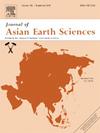Decarbonated eclogite in the mantle sources of the Wajilitag mafic-ultramafic intrusion, Permian Tarim Large Igneous Province, NW China: Evidence from Zn isotopes
IF 2.4
3区 地球科学
Q2 GEOSCIENCES, MULTIDISCIPLINARY
引用次数: 0
Abstract
The formation of the Tarim Large Igneous Province (TLIP) has been linked to oceanic crust subduction, yet the specific interactions between the subducting crust and the TLIP mantle source remain ambiguous. Zn isotopes, a newly developed stable isotope system, offer promising potential for identifying recycled carbonates within the mantle. Here, a detailed analysis of Zn isotopes in the Wajilitag Fe-Ti oxide-bearing mafic–ultramafic intrusion of the TLIP is presented. The observed δ66Zn values (0.27 ‰ ± 0.03 ‰ to 0.48 ‰ ± 0.02 ‰) are heavier than those found in Mid-Ocean Ridge Basalts (MORBs; 0.24 ‰ to 0.31 ‰), potentially indicating the influence of the incorporation of recycled sedimentary carbonates into the mantle source. However, the subalkaline nature and depleted 87Sr/86Sr compositions of the Wajilitag mafic–ultramafic intrusion suggest that sedimentary carbonate incorporation into the mantle occurs via decarbonation. During these processes, Zn from the carbonates (dolomite and magnesite) is transferred to silicates (diopside and enstatite) with accompanying isotope exchange, resulting in the residual silicates inheriting and preserving the heavy Zn isotope signatures. Together with detailed petrographic observations, Rhyolite-MELTS simulations and MATLAB lsqr () function for quaternary mixing calculations, it is concluded that, variations in Zn isotopes among the intrusion lithofacies are primarily driven by differing degrees of Fe-Ti oxides and olivine accumulation. Additionally, our study highlights the potential role of recycled sedimentary carbonates in deep carbon cycling through decarbonation reactions.
塔里木二叠系大火成岩省瓦吉里塔格基性-超基性岩体地幔源中的脱碳榴辉岩:来自Zn同位素的证据
塔里木大火成岩省的形成与洋壳俯冲有关,但洋壳俯冲与塔里木大火成岩省地幔源之间的具体相互作用尚不清楚。锌同位素作为一种新发现的稳定同位素体系,为地幔内再循环碳酸盐的识别提供了良好的前景。本文对塔里木盆地瓦吉里塔格含铁钛氧化物基性超镁铁质侵入岩中Zn同位素进行了详细分析。观测到的δ66Zn值(0.27‰±0.03‰~ 0.48‰±0.02‰)较洋中脊玄武岩(MORBs)重;0.24‰~ 0.31‰),可能表明再循环沉积碳酸盐对地幔源区的影响。然而,瓦吉里塔格基性-超基性岩体的亚碱性和87Sr/86Sr的亏缺组成表明,沉积碳酸盐通过脱碳作用进入地幔。在此过程中,碳酸盐(白云岩和菱镁矿)中的Zn被转移到硅酸盐(透辉石和顽辉石)中,并伴有同位素交换,导致残余硅酸盐继承并保留了重Zn的同位素特征。结合详细的岩石学观测、流纹岩-熔体模拟和MATLAB lsqr()函数第四纪混合计算,认为侵入岩相中Zn同位素的变化主要是由不同程度的Fe-Ti氧化物和橄榄石聚集驱动的。此外,我们的研究强调了再生沉积碳酸盐岩在深层碳循环中通过脱碳反应的潜在作用。
本文章由计算机程序翻译,如有差异,请以英文原文为准。
求助全文
约1分钟内获得全文
求助全文
来源期刊

Journal of Asian Earth Sciences
地学-地球科学综合
CiteScore
5.90
自引率
10.00%
发文量
324
审稿时长
71 days
期刊介绍:
Journal of Asian Earth Sciences has an open access mirror journal Journal of Asian Earth Sciences: X, sharing the same aims and scope, editorial team, submission system and rigorous peer review.
The Journal of Asian Earth Sciences is an international interdisciplinary journal devoted to all aspects of research related to the solid Earth Sciences of Asia. The Journal publishes high quality, peer-reviewed scientific papers on the regional geology, tectonics, geochemistry and geophysics of Asia. It will be devoted primarily to research papers but short communications relating to new developments of broad interest, reviews and book reviews will also be included. Papers must have international appeal and should present work of more than local significance.
The scope includes deep processes of the Asian continent and its adjacent oceans; seismology and earthquakes; orogeny, magmatism, metamorphism and volcanism; growth, deformation and destruction of the Asian crust; crust-mantle interaction; evolution of life (early life, biostratigraphy, biogeography and mass-extinction); fluids, fluxes and reservoirs of mineral and energy resources; surface processes (weathering, erosion, transport and deposition of sediments) and resulting geomorphology; and the response of the Earth to global climate change as viewed within the Asian continent and surrounding oceans.
 求助内容:
求助内容: 应助结果提醒方式:
应助结果提醒方式:


